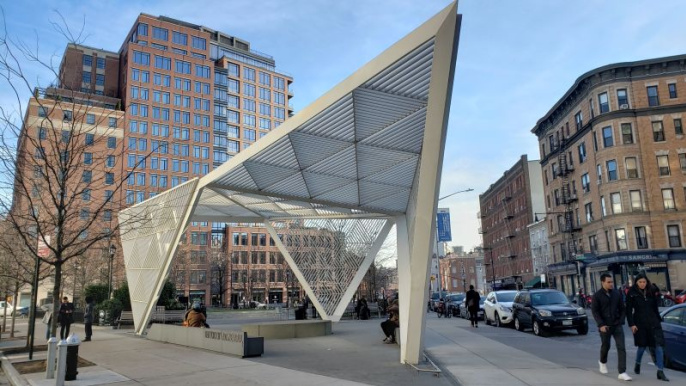
|
New York City, NY United States |
West 12th Street & Greenwich Ave. | New York City AIDS Memorial at St. Vincent’s Triangle |
since 1 December 2016 without names |
NYC AIDS Memorial Park at St. Vincent's Triangle
The NYC AIDS Memorial honors more than 100,000 New Yorkers who died of AIDS (acquired immune deficiency syndrome). It also recognizes the contributions of caregivers and activists who mobilized to provide care for the ill, fight discrimination, lobby for medical research, and alter the drug approval process, effectively changing the trajectory of the epidemic. The Memorial aims to inspire and empower current and future activists, health professionals, and people living with HIV (human immunodeficiency virus, which causes AIDS) in the continuing mission to eradicate the disease.
The Memorial sits on a triangular site that was most recently part of the former St. Vincent’s Hospital campus. Following the closing of the hospital in 2010, a public park was designed for the site through a community review process. The new park was constructed by the Rudin Management Company as part of the conversion of the hospital into a residential development and given to the City of New York in 2017.
This park was selected as the site for the AIDS Memorial because it sits at a unique crossroads in early AIDS history in New York City. The earliest documented AIDS cases, first reported in 1981, disproportionately affected the gay male population, which had large communities in the surrounding West Village and Chelsea neighborhoods. As a result of the number of ill patients filling the beds and hallways of the hospital, in 1984 St. Vincent’s established the first AIDS ward in the city and second in the nation. The Memorial site is less than a block from the LGBT Community Center on 13th Street, where ACT-UP (the AIDS Coalition to Unleash Power) and other AIDS advocacy and support groups first organized. It is also within blocks of the first headquarters of Gay Men’s Health Crisis (GHMC), and the former office of Dr. Joseph Sonnabend, who pioneered community-based research trials for AIDS drugs. His co-op board’s attempt to evict him led to the nation’s first AIDS anti-discrimination case in 1983. Many consider the Memorial’s location as the symbolic epicenter of the epidemic and the mobilization against it.
The Memorial’s white triangular steel sculpture, central fountain, and benches were designed by studio ai architects, selected through an international design competition. Renowned visual artist Jenny Holzer chose and arranged passages from “Song of Myself” (1855), poet Walt Whitman’s transcendent celebration of hope, unity, and human dignity, which are engraved in the Memorial’s granite pavement.
The NYC AIDS Memorial honors more than 100,000 New Yorkers who died of AIDS (acquired immune deficiency syndrome). It also recognizes the contributions of caregivers and activists who mobilized to provide care for the ill, fight discrimination, lobby for medical research, and alter the drug approval process, effectively changing the trajectory of the epidemic. The Memorial aims to inspire and empower current and future activists, health professionals, and people living with HIV (human immunodeficiency virus, which causes AIDS) in the continuing mission to eradicate the disease.
The Memorial sits on a triangular site that was most recently part of the former St. Vincent’s Hospital campus. Following the closing of the hospital in 2010, a public park was designed for the site through a community review process. The new park was constructed by the Rudin Management Company as part of the conversion of the hospital into a residential development and given to the City of New York in 2017.
This park was selected as the site for the AIDS Memorial because it sits at a unique crossroads in early AIDS history in New York City. The earliest documented AIDS cases, first reported in 1981, disproportionately affected the gay male population, which had large communities in the surrounding West Village and Chelsea neighborhoods. As a result of the number of ill patients filling the beds and hallways of the hospital, in 1984 St. Vincent’s established the first AIDS ward in the city and second in the nation. The Memorial site is less than a block from the LGBT Community Center on 13th Street, where ACT-UP (the AIDS Coalition to Unleash Power) and other AIDS advocacy and support groups first organized. It is also within blocks of the first headquarters of Gay Men’s Health Crisis (GHMC), and the former office of Dr. Joseph Sonnabend, who pioneered community-based research trials for AIDS drugs. His co-op board’s attempt to evict him led to the nation’s first AIDS anti-discrimination case in 1983. Many consider the Memorial’s location as the symbolic epicenter of the epidemic and the mobilization against it.
The Memorial’s white triangular steel sculpture, central fountain, and benches were designed by studio ai architects, selected through an international design competition. Renowned visual artist Jenny Holzer chose and arranged passages from “Song of Myself” (1855), poet Walt Whitman’s transcendent celebration of hope, unity, and human dignity, which are engraved in the Memorial’s granite pavement.
The Memorial is a place of contemplation and provides a shelter for reflection and remembrance of the men, women, and children lost to AIDS. It also serves as a gathering place and reminder of the work that remains to defeat the disease. The memorial was dedicated on World AIDS Day, December 1, 2016.
Photo © New York City Parks
https://www.nycgovparks.org/parks/nyc-aids-memorial-park-at-st-vincent-s-triangle/history
1 July 2017
New York City Parks, New York City








































